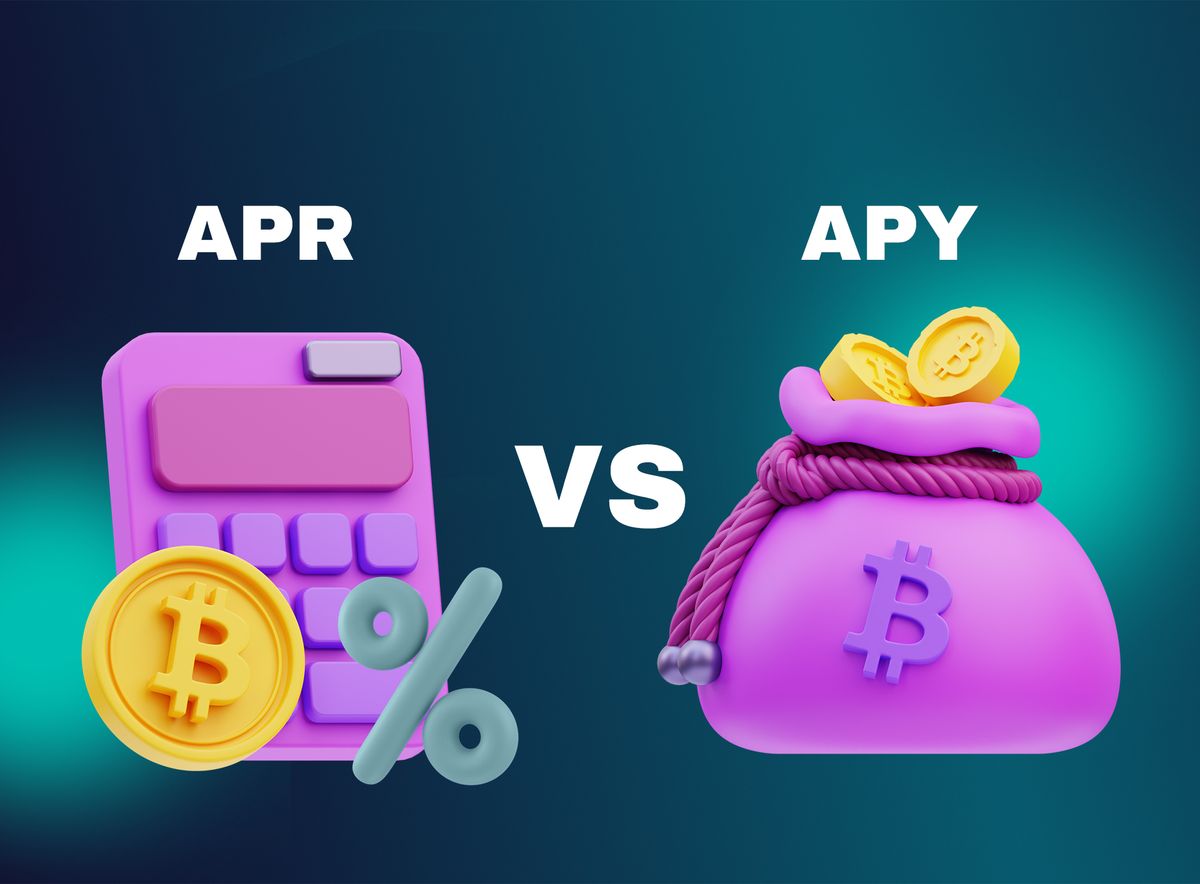APR vs. APY in Crypto: What You Need to Know
Learn how APR and APY are calculated in crypto, which yields more, and when to choose one over the other for your DeFi/Crypto earnings.

TABLE OF CONTENT:
1. Introduction
2. What is APR?
3. What is APY?
4. What is the Difference Between APR and APY?
5. How to Calculate APR and APY
6. Factors to Consider
7. Closing Thoughts
8. FAQs
Everyone likes money until it comes to the mathematical aspect of it. I mean, who would hate making profits, right?
But do you remember when you were in secondary school and would always groan when the Maths teacher announced to the class that the topic for the day was Interest and Percentage?
Exactly! No one wants to rack their brains with calculations, especially when that calculation comes with a formula.
But see where crypto and decentralised finance has led you today.
Let’s face it. There is no way you would want to become financially successful without folding up your sleeves and diving into calculations.
How would you know your profit? How would you know your loss? How would you be able to separate your gains from your investment capital?
Now you are beginning to understand just how important this aspect of finance is, aren’t you? Great, we’re all caught up. Let’s get on from here, then.
Cryptocurrency has transformed the financial landscape, bringing about new opportunities and terms that might seem complex at first glance.
Among these terms, APR (Annual Percentage Rate) and APY (Annual Percentage Yield) are essential concepts that every crypto investor should understand.
Remember, these terms might seem complex at first. Piecing “Annual,” “Percentage,” and “Rate” together would certainly do that. But don’t worry. They are as simple as counting notes on a machine. So, without mincing words, let’s look at the key differences between APR and APY and how to calculate them.
First of all:
What is APR?
APR, or Annual Percentage Rate, is essentially the yearly interest rate associated with borrowing or lending in crypto. It's a simple percentage that tells you the cost or profit of your funds over a year without considering the effects of compounding.
To break it down further, let's say you decide to invest $1,000 in a crypto lending platform with a 5% APR. This means that, at the end of the year, you would earn $50 in interest. It's a direct calculation – with no complications relating to compounding involved.
If you're borrowing instead of lending, the APR would represent the annual cost of that loan. In our $1,000 example, with a 5% APR for borrowing, you'd be paying $50 in interest over the year.
So, in essence, APR explains the annualised interest rate, making it an easy metric for understanding the basic costs and gains associated with crypto lending and borrowing.
What is APY?
While APR (Annual Percentage Rate) provides a basic annualised representation of the interest rate, APY, or Annual Percentage Yield, takes things a step further by factoring in compounding. APY reflects an investment's actual earnings or costs over a year, considering the impact of reinvesting or compounding the interest earned.
Let's break this down with an example as well. Imagine you invest $1,000 in a crypto asset with a 5% APY that compounds quarterly. In this case, after the first quarter, you would earn $12.50 in interest (5% of $1,000). Now, here's where it gets interesting – in the second quarter, you not only earn interest on your initial $1,000 but also on the $12.50 you earned in the first quarter. This compounding effect continues throughout the year.
By the end of the year, your $1,000 investment would have earned $51.19. The additional $1.19 comes from the interest earned on the interest you already accumulated in the previous quarters. This compounding mechanism sets APY apart from APR, as it gives a more accurate representation of the true annualised return on your investment. It's a crucial metric for anyone looking to maximise their returns in crypto.
What is the Difference Between APR and APY?
The main difference between APR and APY lies in how they account for compounding. In crypto investments, compounding can significantly impact the actual returns on your investment.
Let’s look at another example:
Suppose you're looking at two crypto lending platforms offering 5% APR but with different compounding frequencies. Platform A compounds interest quarterly, while Platform B compounds monthly.
- For Platform A (compounding Quarterly):
$1,000 ✕ (1 + 0.05/4)4 = $1,051.19
- For Platform B (compounding monthly):
$1,000 ✕ (1 + 0.05/12)12 = $1,051.61
That is:
- For Platform A, which compounds interest quarterly, your final amount after one year would be approximately $1,051.19.
- For Platform B, which compounds interest monthly, your final amount after one year would be approximately $1,051.61.
Even though both platforms have a 5% APR, Platform B, with more frequent compounding, yields a slightly higher return due to the compounding effect.
How to Calculate APR and APY
To calculate APR, you need to know the interest rate and any additional fees the lender charges. For instance, if you borrow $1,000 at a 5% annual interest rate with no additional costs, your APR is simply 5%. On the other hand, APY accounts for compounding, which means your investment earns interest on both the initial amount and the accrued interest.
To calculate APY, use the formula:
APY = (1 + r/n)n − 1, where r is the annual interest rate and n is the number of times interest is compounded per year.
Let's say you invest $1,000 in a crypto asset with a 5% interest rate compounded quarterly. Plug in the values: r = 0.05 and n = 4.
The formula gives us (1 + 0.05/4)4 - 1, which equals approximately 5.09% APY.
This means your $1,000 investment would grow to $1,050.90 after one year.
Factors to Consider
1. Compound Interest Impact: The more frequently interest compounds, the higher the APY compared to the APR for the same nominal interest rate.
2. Cryptocurrency Instability: Cryptocurrency investments come with inherent risks, and it's essential to consider the potential impact of market instability on both APR and APY.
3. Liquidity and Lock-in Periods: Some crypto platforms may offer higher APR/APY but come with more extended lock-in periods or limited liquidity.
4. Inflation Considerations: Inflation can diminish the actual value of crypto returns, so it's crucial to factor this into your investment strategy.
5. Smart Contract Risks: Investing in decentralised finance (DeFi) platforms involves risks associated with smart contract vulnerabilities. Be aware of these risks before committing funds.
6. Market Conditions: The cryptocurrency market is dynamic, and interest rates can vary based on market conditions, supply, and demand.
7. Tax Implications: Gains from crypto investments are subject to taxation. Understanding the tax implications is crucial for accurate financial planning.
8. Diversification Benefits: Consider diversifying your crypto investments to reduce risks associated with individual platforms or assets.
9. Regulatory Environment: Keep abreast of the regulatory environment, as it can impact the legality and stability of certain crypto investments.
10. Security Measures: Prioritise platforms with robust security measures to protect your funds from potential cyber threats.
Closing Thoughts
Understanding the distinctions between APR and APY is crucial for making informed decisions in crypto investments. By grasping these concepts and considering various factors, investors can confidently navigate the crypto landscape, ultimately optimising their returns while managing associated risks.
FAQs
Q1. Can APR be higher than APY?
A1. Yes, if compounding is more frequent, the APY can be higher than the APR for the same nominal interest rate.
Q2. How does market instability affect APR and APY?
A2. Cryptocurrency prices can fluctuate, impacting returns. Higher instability may result in increased risks and rewards.
Q3. Are APR and APY guaranteed returns?
A3. No, they represent potential returns, and actual results may vary due to market conditions and other factors.
Q4. What is the impact of inflation on crypto returns?
A4. Inflation can diminish the real value of returns, so it's important to consider this factor in your investment strategy.
Q5. Can I lose money with crypto investments?
A5. Yes, like any investment, there are risks involved. Understanding these risks is crucial for informed decision-making.
Q6. How does compounding work in crypto investments?
A6. Compounding involves earning interest on both the initial investment and the interest already earned, leading to exponential growth.
Q7. Are there taxes on crypto gains?
A7. Yes, gains from crypto investments are generally subject to taxation. However, please consult a tax professional for accurate guidance.
Q8. What is DeFi, and why does it matter in crypto investments?
A8. DeFi (Decentralised Finance) refers to financial services built on blockchain technology, offering innovative investment opportunities but also posing unique risks.
Q9. Can I withdraw my funds from crypto lending platforms anytime?
A9. It depends on the platform. Some may have lock-in periods, and liquidity can vary.
Q10. How can I secure my crypto investments?
A10. Use secure wallets, enable two-factor authentication, and choose reputable platforms with a strong security track record.
Disclaimer: This article was written to provide guidance and understanding. It is not an exhaustive article and should not be taken as financial advice. Obiex will not be held liable for your investment decisions.




